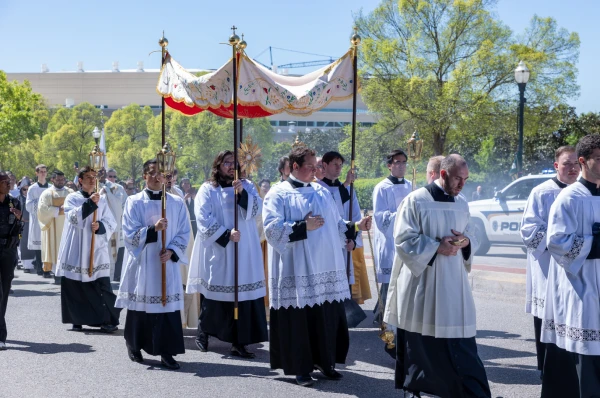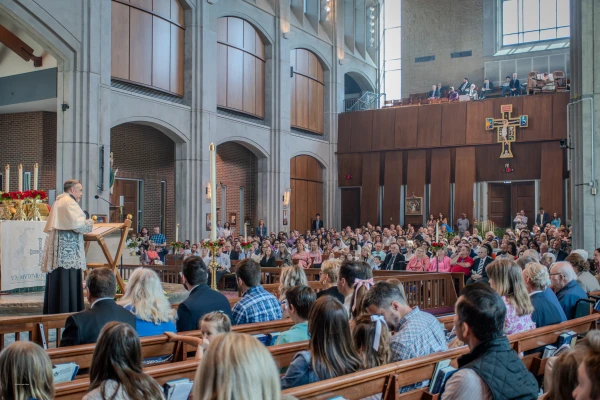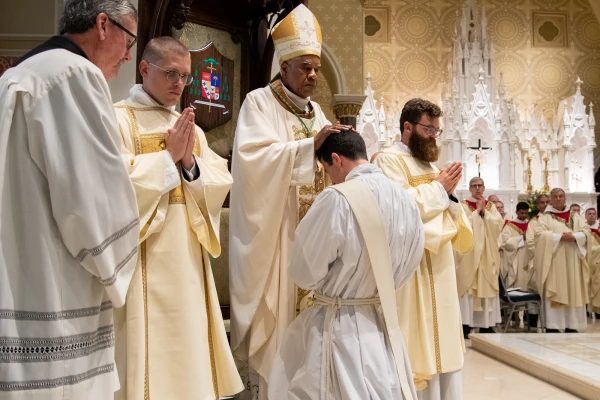Washington, D.C. Newsroom, Jul 2, 2024 / 06:00 am
While parish closures and consolidations have made headlines across the United States, a lively community of devout Catholics dedicated to deepening their faith has flourished in the South, particularly in South Carolina.
“Being in the Bible Belt, or a predominantly Protestant area, can be a challenge in our faith and causes us to have to know why we believe what we believe,” Father Rhett Williams, vocations director of the Diocese of Charleston and chaplain at the University of South Carolina, told CNA.
“The beauty of the Catholic faith is the more you get into it, for whatever reason, the more you come to love it. In the Southeast, people are moving for different reasons, finding a vibrant community that intrigues them.”
In South Carolina, the Diocese of Charleston traces its history back to its establishment on July 11, 1820, by Pope Pius VII. Originally encompassing three states, the diocese now just covers South Carolina and consists of 95 parishes, 21 missions, 32 diocesan schools, and Charleston as its see.
When compared with other areas in the 1980s, South Carolina was found to be the least Catholic state in the country — only 2% of its population identified with the religion. However, this number shot up following Pope John Paul II’s 1987 visit to the University of South Carolina as part of an ecumenical conference.
Addressing 60,000 people gathered in a football stadium, John Paul expressed his hope for attendees to embrace “great love for truth — the truth about God, the truth about man, and the truth about the world. I pray that through truth you will serve humanity and experience real freedom. In the words of Jesus Christ: ‘You will know the truth, and the truth will set you free.’”
Since then, South Carolina has seen its Catholic community grow to over 218,000 registered Catholics, or 4.07% of the state’s current population, according to the Diocese of Charleston. This number represents a more than 200% increase from the state’s Catholic population in 1987.

Young adult involvement has grown exponentially
According to statistics shared with CNA by the Diocese of Charleston, there has been a registered parishioner increase of 14% in the last decade. While this is in large part due to the influx of converts and individuals moving to the South from various regions, it is also due to the strong rise in Catholicism among the state’s younger population.
Numerous colleges and universities throughout South Carolina have witnessed heightened involvement in both campus ministry and FOCUS (Fellowship of Catholic University Students) programs.
“This is my fourth year [at St. Thomas More Catholic Church], and in the last few years, pretty much every metric for campus ministry has tripled or quadrupled,” Williams said. These metrics consist of attendance at Masses, retreats, and other activities put on by campus ministry.
Having to account for these growing numbers, St. Thomas More implemented an additional Mass to its weekend schedule.
“There was one priest and four Masses: A vigil, two morning ones, and one evening Mass. What we found pretty soon was that we didn’t have room anymore, so we added a 9 p.m. Mass, still with only one priest,” he explained. “Now, the 9 p.m. Mass averages about 70% capacity during the year and is still filling. At USC, we are trying to find donors to help us build a new church because we simply can’t fit the students into our current chapel.”
Reflecting this demand for increased Catholic involvement among younger adults, South Carolina will open its first Catholic college this coming fall in Greenville. Rosary College will offer students a two-year liberal arts education in the Benedictine tradition, spearheaded by Catholic scholars and prominent author and convert Father Dwight Longenecker.
A city known for its Catholic community
(Story continues below)
Greenville, renowned for its robust Catholic community, stands out as one of the state’s foremost hubs of Catholicism in recent years. The area boasts multiple parishes — Prince of Peace, St. Mary Magdalene, St. Mary’s, Our Lady of the Rosary, and St. Anthony of Padua, among others — where Masses often overflow with faithful, young families.

In fact, many families from all over the country have moved to the Greenville area for the excellent Catholic churches and schools.
One such family is the Billings. Troy and Kathleen Billings, who relocated from Chicago to Greenville in the summer of 2020, described their move as a “leap of faith.”
“At the time, [Greenville] was just beginning to grow as a Catholic community, and it has now grown tremendously within the last four years,” Kathleen Billings told CNA. “We felt that the Lord was calling us here, so we made that leap of faith. And come to find out, many other families have felt that same calling.”
Since settling in Greenville, the Billings have witnessed firsthand the Church’s presence in the region: “Our Masses are beautiful, the churches are packed, and the community is incredible.”
As a way to remain active within this Catholic scene, the Billings started a monthly rosary ministry at their home. With 20 people at its first meeting four years ago, the ministry now averages “250-350 participants monthly, drawn from all of the Catholic churches in the Upstate [region of South Carolina].”
Similarly inspired by this burgeoning community, Michael Sandifer relocated with his family from Wisconsin to Greenville five years ago.
As the pastoral associate of adult faith formation at Prince of Peace Catholic Church, Sandifer shared that one of his responsibilities consists of working “with people who come into the Church and are interested in learning and knowing more about the Catholic faith.”
“Every day, we’ll get a phone call or email saying, ‘I am new to the area, we are looking into Prince of Peace,’” he continued. “It’s been a huge uptick that isn’t surprising, but definitely rewarding.”
Also reflecting this Catholic liveliness in the Greenville area is St. Anthony of Padua Catholic Church, which, according to its website, welcomes “all people to worship God in the genius of African American Catholic spirituality.” Here, parishioners are able to share in the Catholic faith across many ministries and programs, including a Hiking Ministry, Prison Ministry, a Living Waters Bible Study, and a Women’s Council, among many others.
Echoing this growing interest and parishioner involvement, the Diocese of Charleston has seen a surge in vocations.
This past year, two men were ordained to the priesthood and four to the transitional diaconate. With 28 in formation for the 2024-2025 year, the diocese now has more seminarians than ever before in its recent history.

How does the South compare with the rest of the country?
Compared with other regions in the United States, the South — which includes South Carolina — currently hosts the highest percentage of Catholics (29%). Meanwhile, former Catholic stronghold states in the Northeast, such as Pennsylvania and Massachusetts, have experienced a rapid decline in their Catholic populations over recent decades.
“There are so many families here doing their best to live faithfully, and clergy who love to love the Lord and serve his people. All of that speaks volumes to what God is doing here,” Sandifer said. “I foresee the Church in South Carolina having an influence on our neighboring communities, and I am excited to witness how it continues to grow.”
This story was updated on July 3, 2024, with the correct number of Catholics in the Diocese of Charleston and with information on St. Anthony of Padua Parish.






